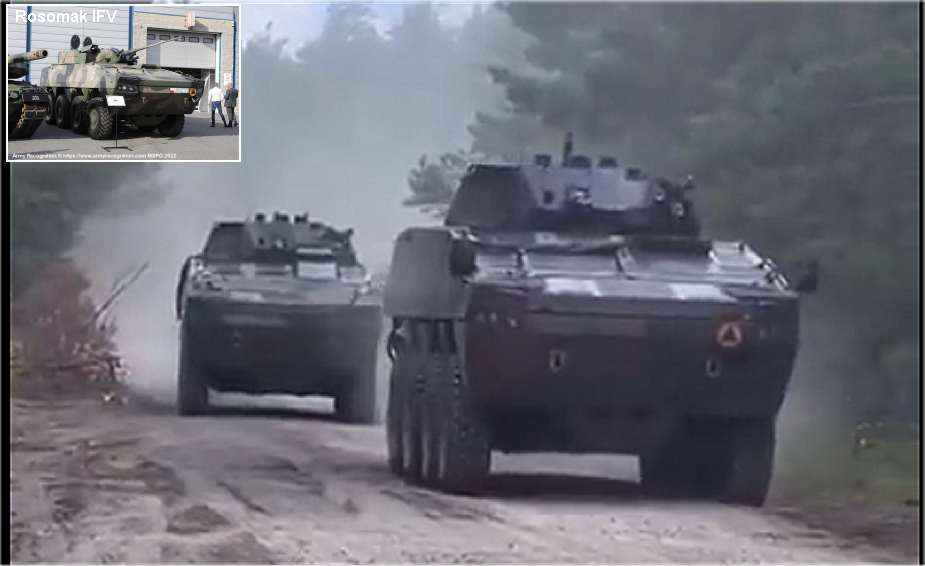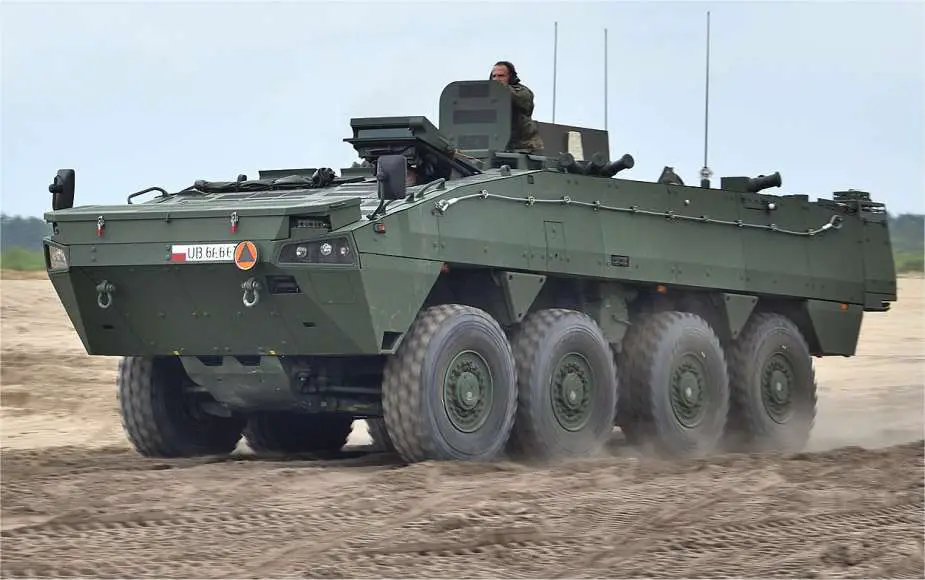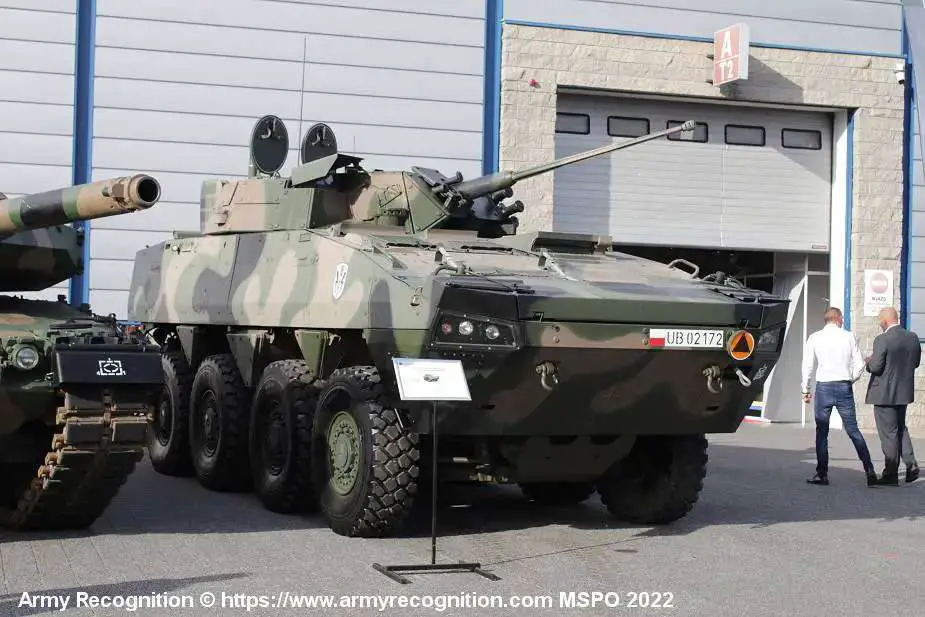- Army
- Conflicts in the world
- Israel - Iran conflict 2025
- Pakistan - India Conflict 2025
- Russia Ukraine War 2022
- Libya conflict day by day
- HAMAS - Israel War 2023
- Operation Serval in Mali French Army
- Sangaris operation Central African Republic
- Sangaris opération militaire République Centreafrique
- Ukraine - Russia conflict
- Syria conflict news
- Defence & Security Industry Technology
- Armies in the world
- Analysis Defense and Security Industry
- Conflicts in the world
- Navy
- Air
Pictures reveal that Ukraine army now uses Polish Rosomak IFV 8x8 Infantry fighting Vehicles
According to a tweet from Getty on July 3, 2023, the Ukrainian 44th Mechanized Brigade has announced the delivery of Polish Rosomak APCs, however, upon examining the images, it becomes evident that the vehicles are actually Infantry Fighting Vehicle (IFV) variants equipped with a turret armed with a 30mm cannon and a 7.62mm machine gun. This type of error could have been easily avoided if the distinctions between APC and IFV variants were kept in mind.
Follow Army Recognition on Google News at this link

The Rosomak APC variant has an open turret with a 7.62mm or 12.7mm machine gun while the IFV variant features a closed turret with a 30mm cannon (Picture sources TikTok and Army Recognition)
APCs and IFVs are vital components of modern military forces, each serving distinct roles and offering unique capabilities on the battlefield. Although both vehicles share the purpose of transporting infantry troops, they have fundamental differences in their main functions and features.
APCs are military vehicles, either wheeled or tracked, designed primarily for transporting infantry troops and their equipment to the battlefield safely. Their main focus is on providing secure and protected mobility for infantry forces. APCs are equipped with armored hulls to shield against small arms fire, shrapnel, and light explosives. Typically, they have limited armament, mostly machine guns or automatic weapons, for self-defense purposes. The primary emphasis of APCs is on mobility and troop transport, enabling infantry units to be quickly deployed and dismounted when necessary. They are particularly suited for peacekeeping missions, urban warfare, and scenarios that require safe and rapid troop movement.
On the other hand, IFVs are combat vehicles meant to carry infantry troops into battle while offering substantial firepower support. They are equipped with advanced armaments, including automatic cannons, anti-tank guided missiles (ATGMs), and machine guns. The primary role of IFVs is to engage and neutralize enemy targets, such as armored vehicles, fortifications, and personnel. IFVs have heavier armor compared to APCs, providing enhanced protection for the crew and infantry against various threats on the battlefield. While they do offer mobility to support combined arms operations, their primary focus is on providing fire support to infantry units during combat. IFVs are well-suited for offensive operations, where infantry requires direct fire support to achieve tactical objectives.
APCs typically have light armaments, such as machine guns or automatic weapons, primarily for self-defense and light suppression. IFVs, in contrast, are heavily armed, with cannon systems, missiles, and machine guns to engage enemy targets effectively.
APCs emphasize troop protection with armored hulls designed to withstand small arms fire, shrapnel, and light explosives. IFVs have heavier armor compared to APCs, offering increased protection against more significant threats, including anti-tank weaponry.
APCs are used primarily for safe troop transport and mobility, especially in scenarios requiring rapid troop deployment and evacuation. IFVs are utilized in offensive operations, supporting infantry units with direct fire capabilities, and engaging enemy targets during combat.
Both APCs and IFVs prioritize mobility, enabling them to traverse various terrains. However, APCs may prioritize speed and versatility, while IFVs balance mobility with enhanced protection and firepower.
In conclusion, APCs and IFVs are distinct military vehicles designed to meet specific battlefield requirements. APCs focus on secure troop transportation with limited armament for self-defense, while IFVs prioritize infantry fire support with heavy armament and enhanced protection. Understanding the differences between these vehicles is essential for effectively deploying them in various operational scenarios and optimizing their roles in modern military strategies.
The vehicle in question, the Rosomak 8x8, was developed by Wojskowe Zakłady Mechaniczne (Military Mechanical Works) in Poland, in partnership with the Finnish company Patria, the manufacturer of the SISU XA-185 also seen in Ukrainian service. Its name "Rosomak" translates to "Wolverine" in English. The Rosomak was designed to replace the aging BWP-1 (BMP-1) tracked IFVs in service with the Polish Armed Forces. Due to its advanced features and capabilities, the Rosomak IFV has gained popularity in the international market, leading to export to several countries, with Indonesia being one of the recipients, where it is known as the "Anoa.".

The Rosomak 8x8 in its APC variant with an open turret armed with a 7.62mm or a 12.7mm machine gun (Picture source Army Recognition)
The Rosomak 8x8 in its Infantry Fighting Vehicle (IFV) variant is equipped with advanced armor, which offers a high level of protection against small arms fire, artillery shell splinters, and other threats commonly encountered on the battlefield. The specific level of protection may vary based on the vehicle's configuration and the selected armor package.
The primary armament of the Rosomak typically consists of an Italian Oto Melara Hitfist-30P gun turret armed with a 30mm ATK Mk 44 cannon and a 7.62mm NATO UKM-2000C machine gun. This turret has advanced fire control systems with thermal sights and an Obra laser warning system connected to six 81mm 902A ZM Dezamet smoke grenade launchers.
The Rosomak has a crew of three members, including a driver, a gunner, and a vehicle commander. Along with its crew, the IFV can carry a squad of infantry troops, generally accommodating around 8 to 12 soldiers. However, the troop capacity can vary depending on the specific variant and the mission requirements.
One notable feature of the Rosomak IFV is its modular design. This design allows it to be adapted for various roles on the battlefield. In addition to the standard infantry carrier variant, there are other configurations available, such as command post vehicles, reconnaissance vehicles, and ambulance variants. Communication and electronic equipment are integral to the Rosomak's capabilities. The vehicle is equipped with modern communication systems, ensuring seamless communication between the crew and supporting units on the field.

The Rosomak 8x8 in its IFV variant with a closed turret armed with a 30mm cannon (Picture source Army Recognition)


























